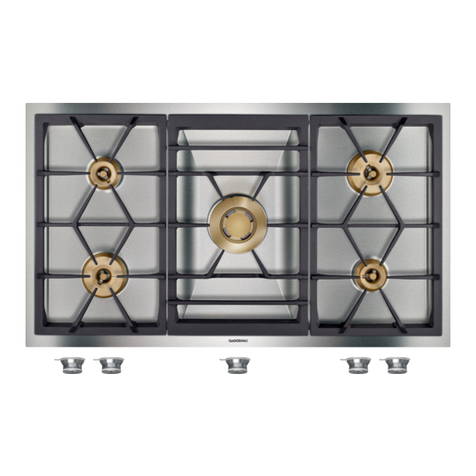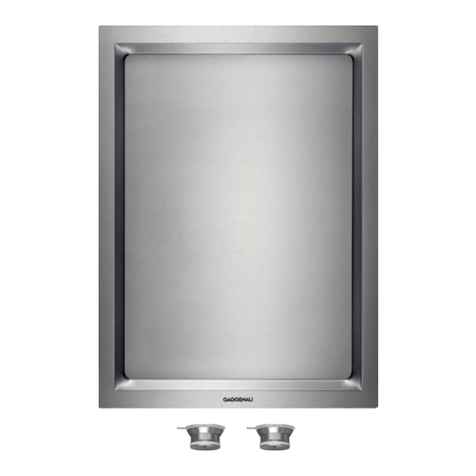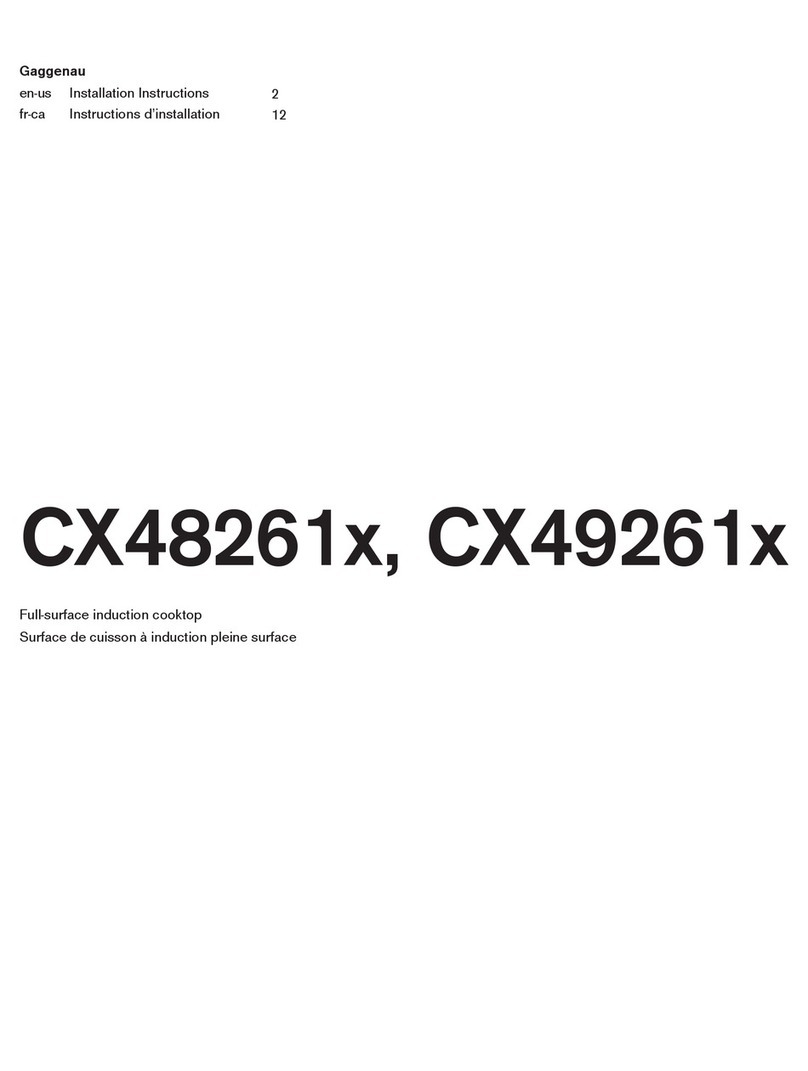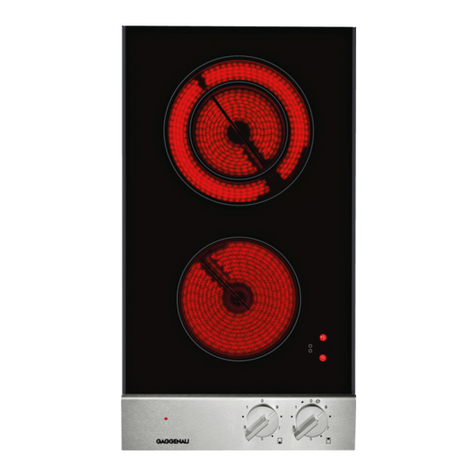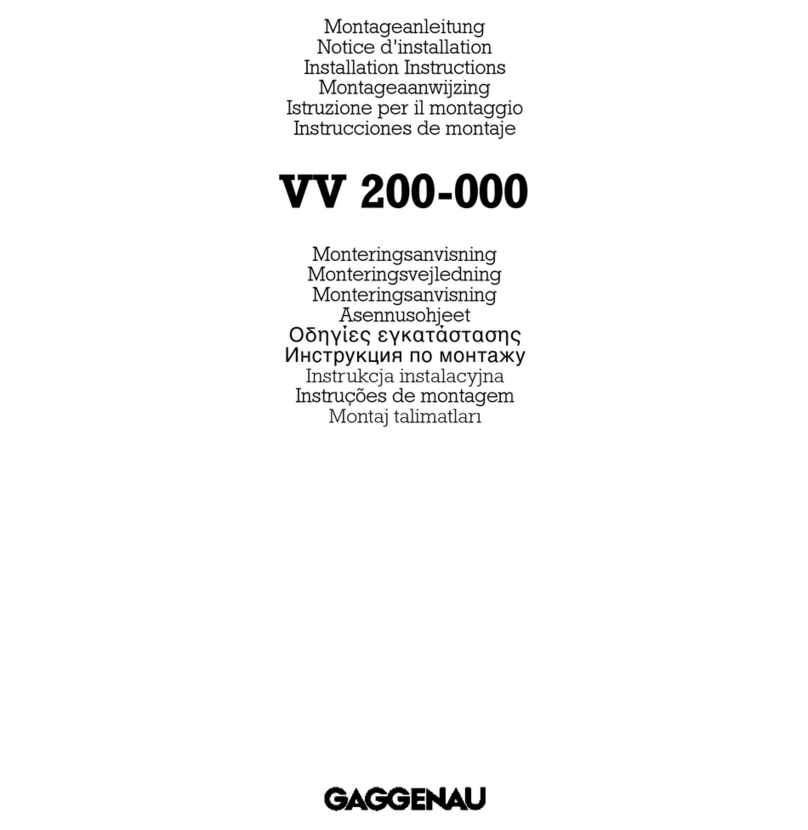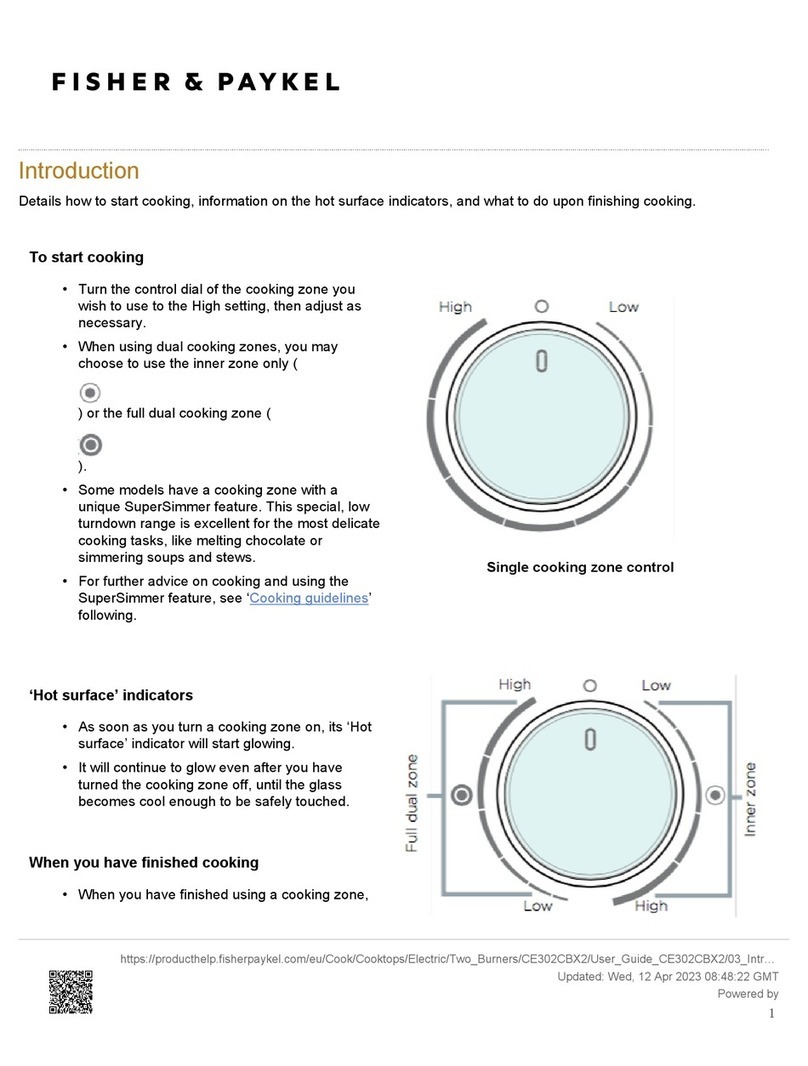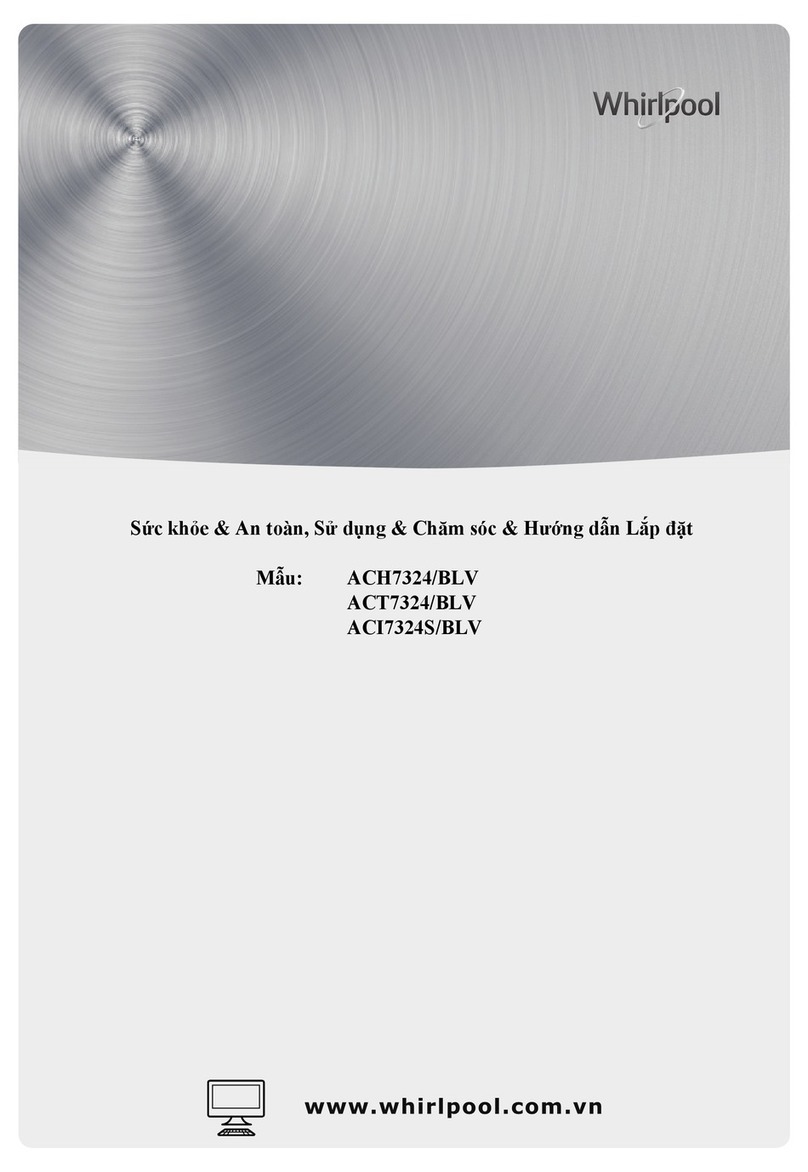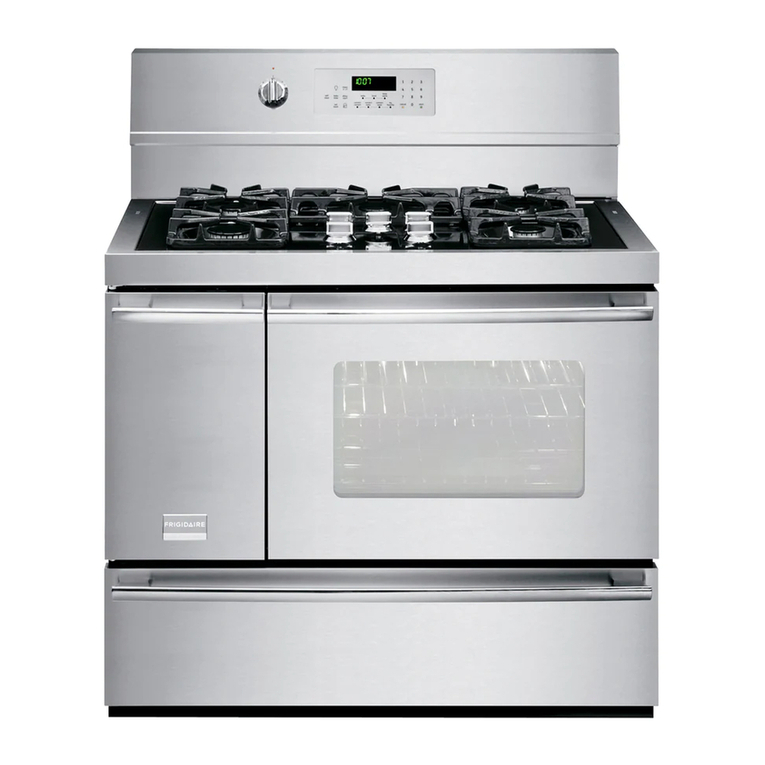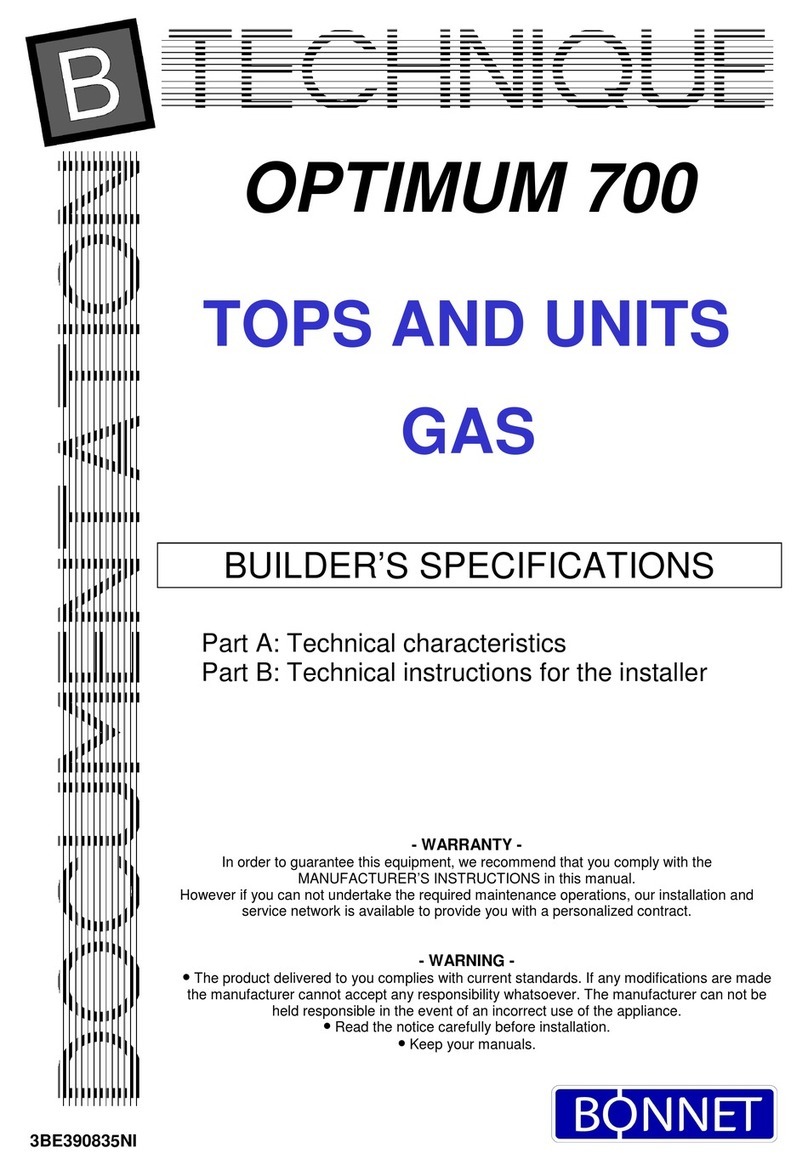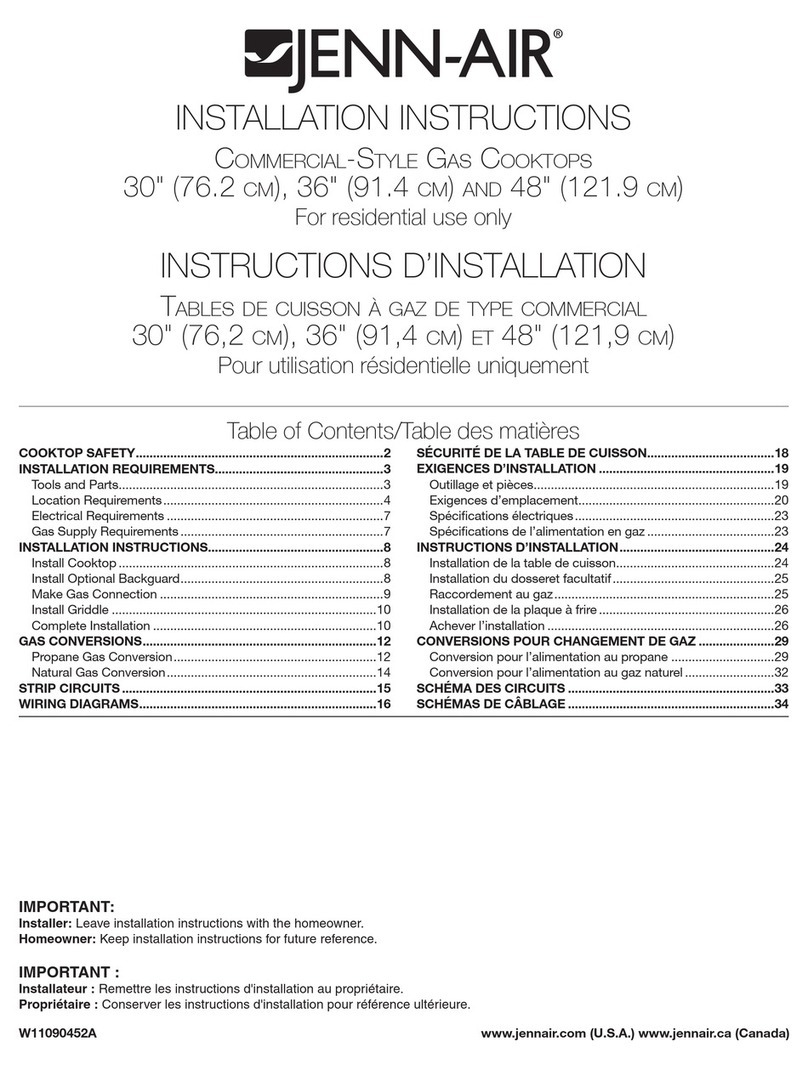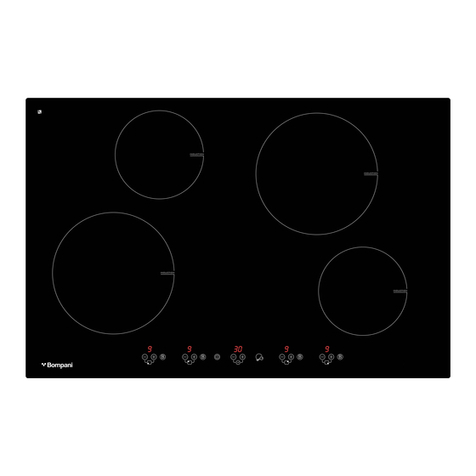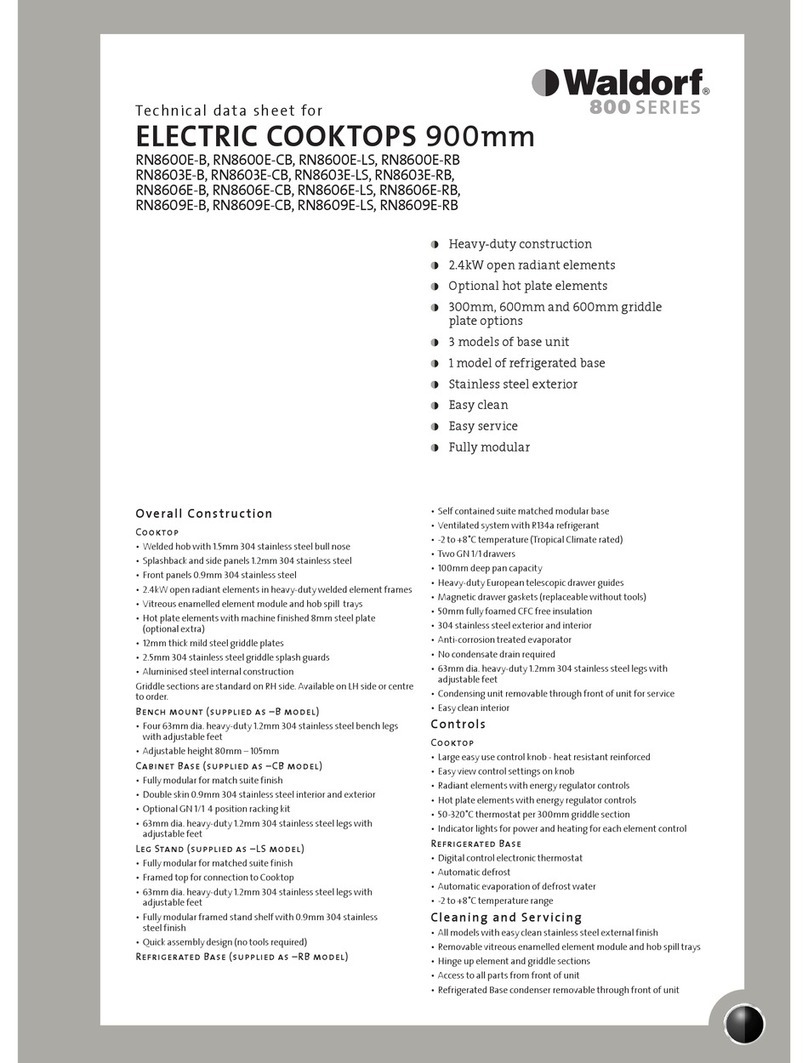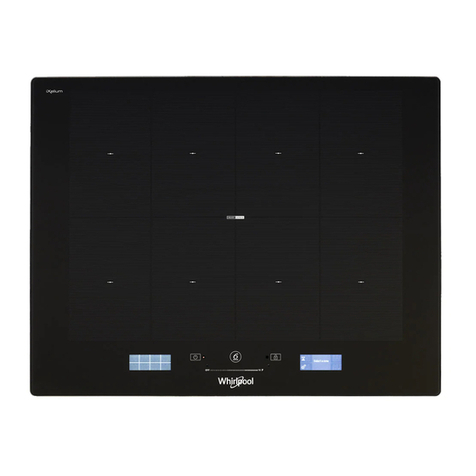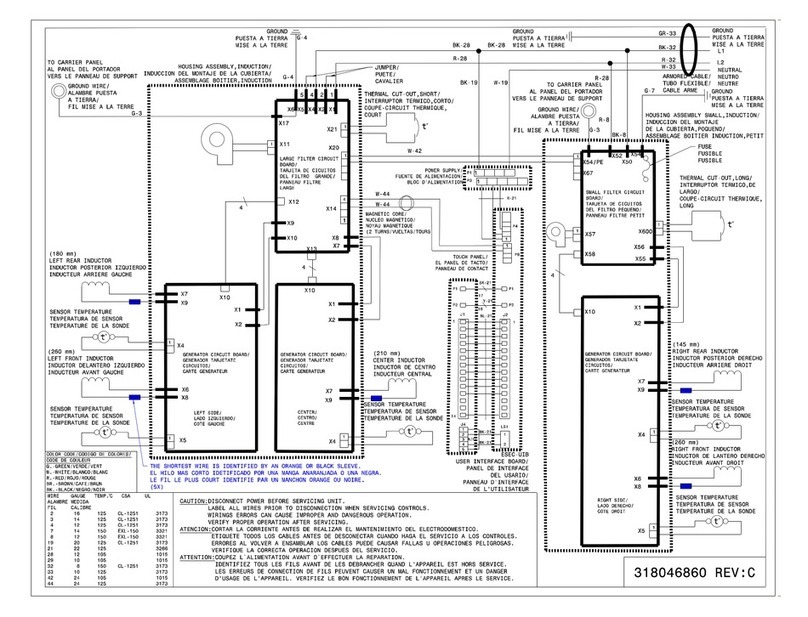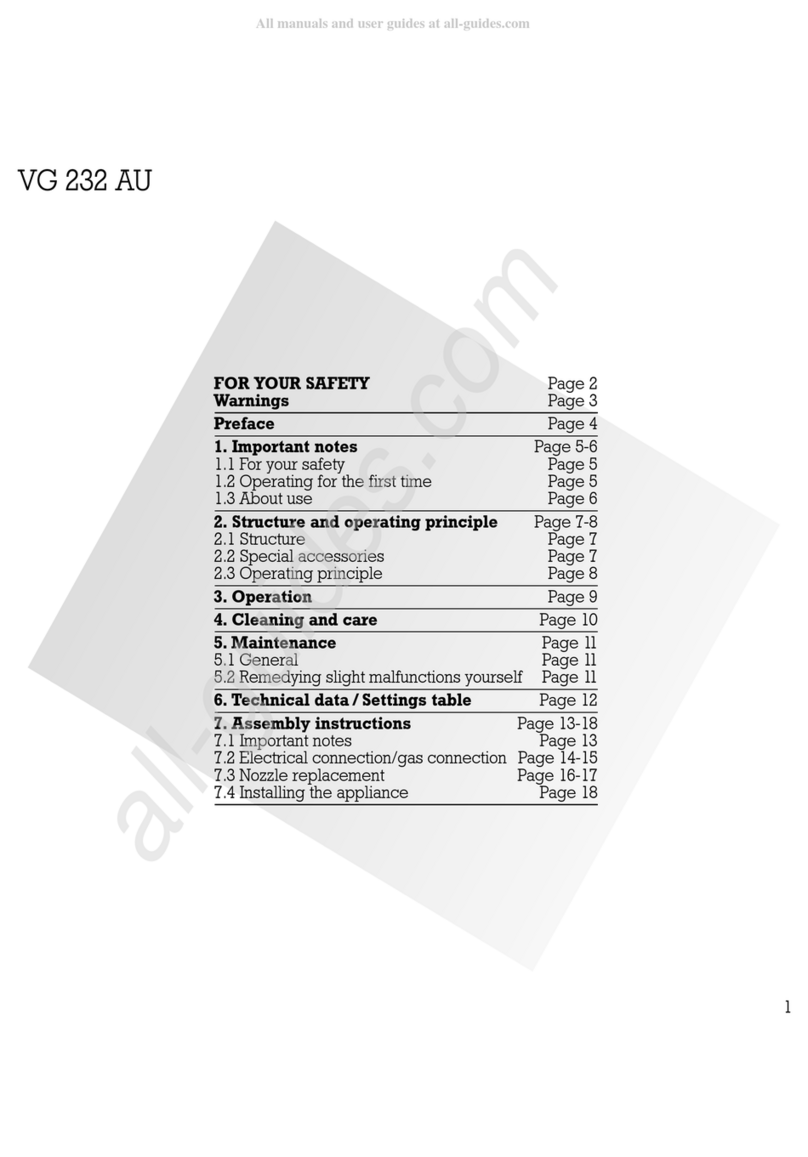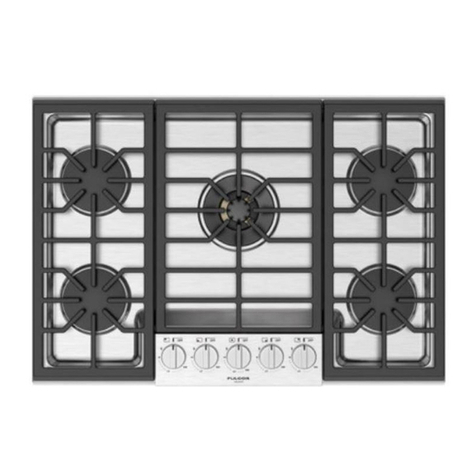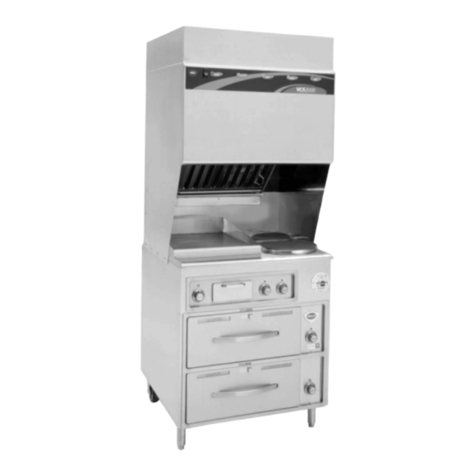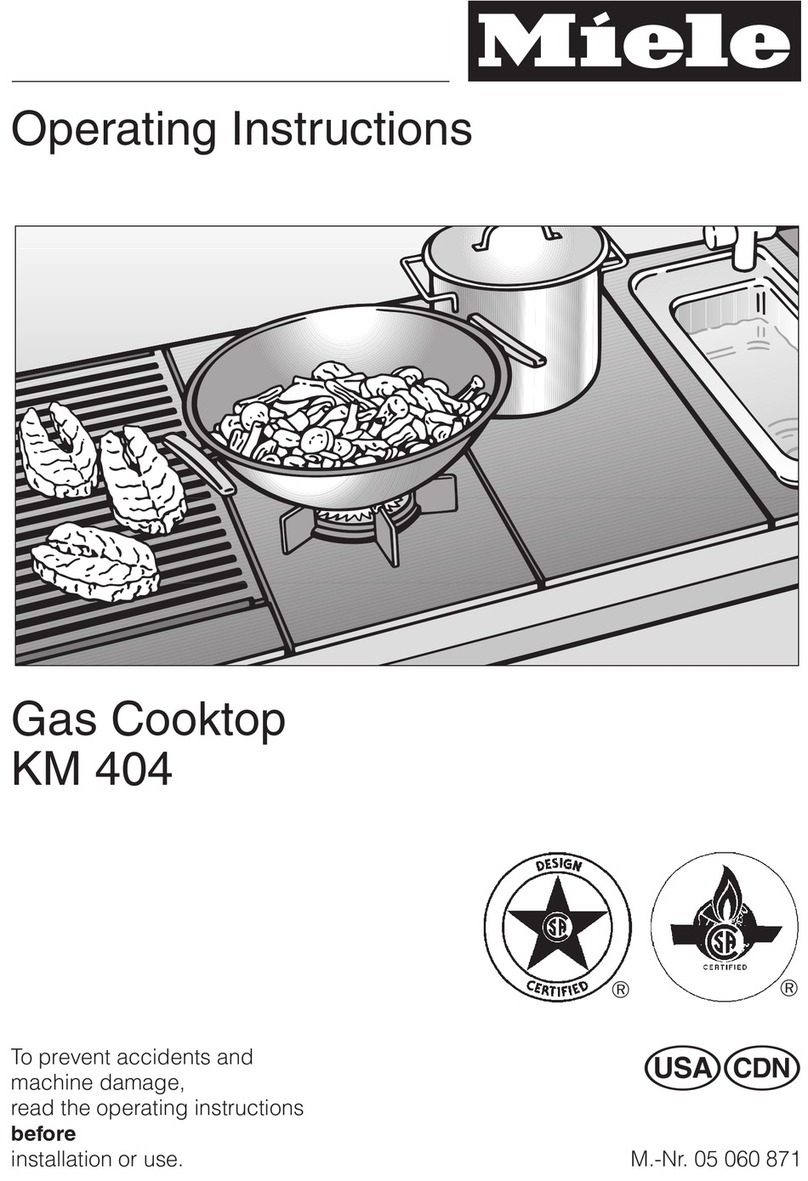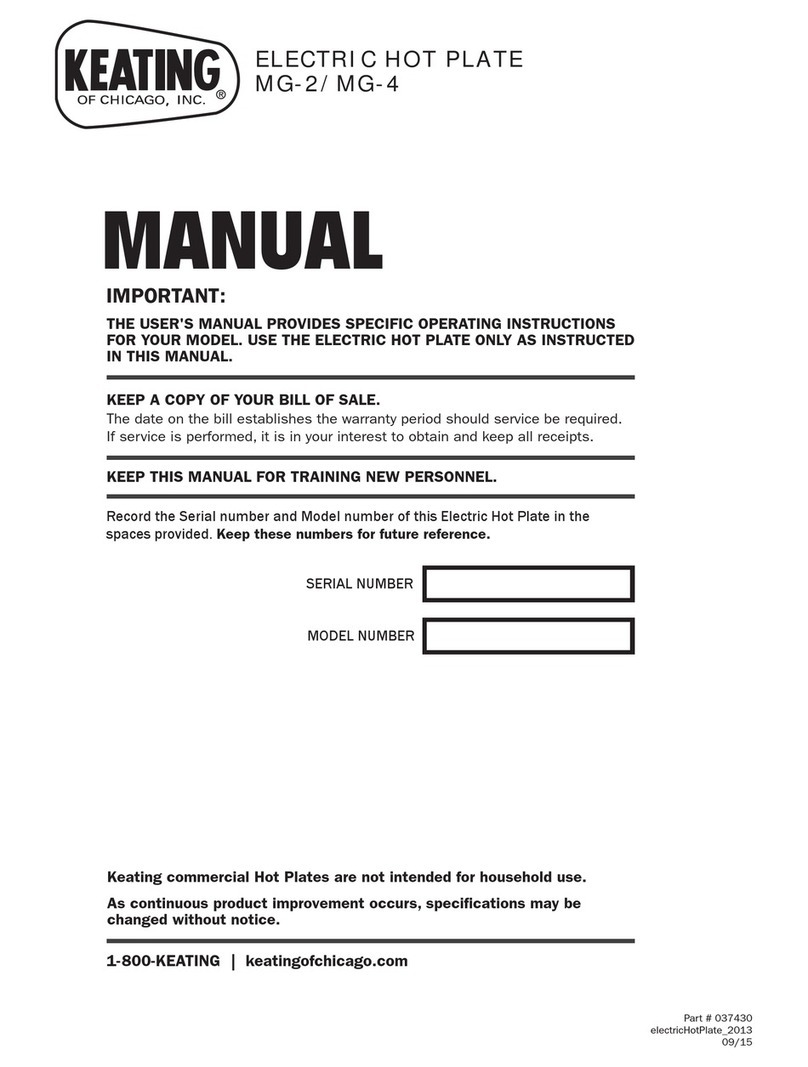
Fitting the appliance
1. Mark the centre of the recess exactly. Fit the mounting rails to
the front and rear of the recess. Make sure the lugs of the
mounting rails lie on the worktop. The centre marking on the
mounting rails must be precisely flush with the centre marking
of the recess.
Note. when fitting the appliance in a stone worktop glue on the
mounting rails with a temperature-resistant two-component
adhesive (metal on stone).
2. For combination with the appliance cover VD 201: secure the
appliance cover on the appliance before installation (refer to
the installation manual of VD 201).
3. Lower the appliance into the cut-out. The snap-in pins on the
appliance must lie exactly on the catch springs. Firmly press
the appliance into the cut-out. The pins on the appliance must
snap into the catch springs.
Removing the appliance
Disconnect the appliance from the power and the gas supply.
Push out the appliance from below.
Caution!
Risk of damage! Do not lever out the appliance from above.
Gas connection
The supply connection point shall be accessible with the
appliance installed.
Using the R½'' (for appliance side) connection elbow provided,
connect the appliance with the associated gasket to a fixed
connection pipe. For natural gas the regulator must be
connected.
If using a flexible connection
This appliance is approved for connection by a CLASS B hose.
Connection is in compliance with AS/NZS 5601.1
There are two ways to carry out the connection to the main gas
line:
■A: The hotplate can be connected with rigid pipe.
■B: Flexible Hose: If installing with a hose assembly, install with
a hose assembly that complies with AS/NZS 1869 (AGA
Approved), 10 mm ID, class Bor D, no more than 1.2 m long
and in accordance with AS/NZS 5601.1. Ensure that the hose
does not contact the hot surfaces of the hotplate, oven,
dishwasher or any other appliance that may be installed
underneath or next to the hotplate. The hose should not be
subjected to abrasion, kinking or permanent deformation and
should be inspected along its entire length with the cooktop in
the installed position. Unions compatible with the hose fittings
must be used and all connections tested for gas leaks.
Before leaving - check all connections for gas leaks with soap
and water. DO NOT use a naked flame for detecting leaks.
Ignite all burners both individually and concurrently to ensure
correct operation of gas valves, burners and ignition. Turn gas
taps to low position and observe stability of the flame for each
burner individually and all together.
Adhere the duplicate data plate to an accessible location near
to the cook top. When satisfied with the cook top, please
instruct the user on the correct method of operation. In case the
appliance fails to operate correctly after all checks have been
carried out, refer to the authorised service provider in your area.
Electrical connection
Check that the appliance has the same voltage and frequency
as the electrical installation system.
The hob is delivered with a mains cable and 3 pin moulded
plug.
Only connect the appliance to sockets which have been fitted
and earthed according to regulations.
The appliance corresponds to type Y: the mains connection
cable must only be replaced by the after-sales service. Check
the cable type and minimum cross section.
Technical data / nozzle table
Total connected load electric 0.8 VA
Nozzle table
Conversion to another type of gas
This gas hob corresponds to the categories specified on the
rating plate. It is possible to convert the appliance to any of the
gases listed on the plate by changing the nozzles. The
modification kit can be ordered via our after-sales service.
Depending on the model the parts required may beincluded in
the scope of delivery.
The conversion must be carried out by an authorised person.
Before carrying out the conversion, turn off the electricity and
gas supply.
Changing the low burn nozzle:
1. Remove pan support and all burner parts.
2. Unscrew two fastening screws (Torx T20) and remove
stovetop.
3. Remove control knob. Remove control panel: Unscrew the two
upper, lateral fastening screws (Torx T20). Raise control panel
in the rear and push it forward. Remove switch cover.
4. The low burn nozzle is located in the gas valve and is screwed
in from above. For easier accessibility, turn switch or remove
securing ring and remove switch. Unscrew the nozzle and
insert the new nozzle as specified in the low-setting nozzle
table. The nozzle must be screwed in fully.
5. Put switch, securing ring, switch cover and control panel back
in place and screw them tight. Put on control knob
Changing the full burn nozzle:
1. Remove securing clips on the burner pipes. Remove burner
pipes. Loosen screw on air-regulating tube. Remove nozzle
fitting
2. Remove nozzle and O-ring for inner circular burner by hand.
Unscrew nozzle for outer circular burner (SW10).
3. Check that O-ring is correctly positioned in new full-burn nozzle
for inner circular burner. Push nozzle onto burner pipe. Screw
new main nozzle for outer circular burner all the way into nozzle
fitting.
4. Put on nozzle fitting and burner pipes. Put on securing clips.
5. Set air-regulating tube to correct dimension after loosening the
screw (see nozzle table). Tighten screw again.
6. Put stovetop in place and screw it tight. Put burner parts and
pan support in place, positioning them correctly.
If it should be necessary to correct the low-setting nozzle as the
result of deviating gas types and pressure, the flow rate can be
increased by turning to the left.
These burners do not require the primary air to be adjusted.
Checking functions after the conversion:
The flames are adjusted correctly if no yellow tips are visible
and if they do not go out when switching over swiftly from the
high to the low setting.
Note. stick the adhesive label included with the nozzle set over
the rating plate of the appliance to document the changeover to
a different gas type.
Gas Natural Gas Propane Gas
Pressure 1.0 kPa 2.75 kPa
CNozzle, full burn, outer 195 110
ANozzle, low burn, outer 88 57
DNozzle, full burn, inner 67 42
BNozzle, low burn, inner 51 31
Air gap adjustment, outer 0 mm 0 mm
Total connected load 18.0 MJ (5 kW) 18.0 MJ (5 kW)
Total consumption 0.47 m³/h 376 g/h
